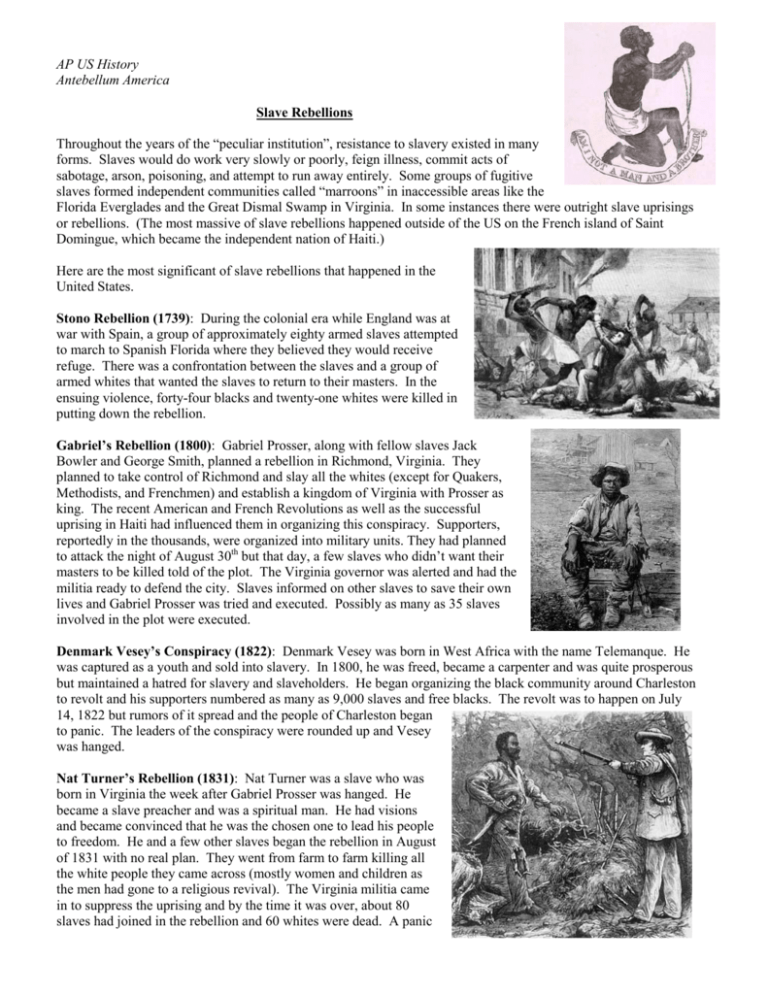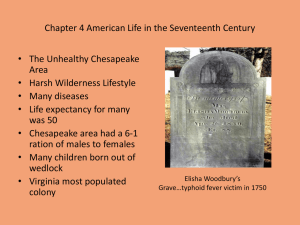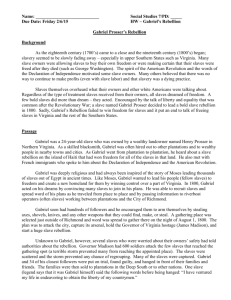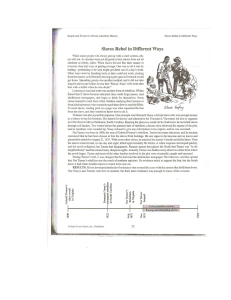Slave Rebellions
advertisement

AP US History Antebellum America Slave Rebellions Throughout the years of the “peculiar institution”, resistance to slavery existed in many forms. Slaves would do work very slowly or poorly, feign illness, commit acts of sabotage, arson, poisoning, and attempt to run away entirely. Some groups of fugitive slaves formed independent communities called “marroons” in inaccessible areas like the Florida Everglades and the Great Dismal Swamp in Virginia. In some instances there were outright slave uprisings or rebellions. (The most massive of slave rebellions happened outside of the US on the French island of Saint Domingue, which became the independent nation of Haiti.) Here are the most significant of slave rebellions that happened in the United States. Stono Rebellion (1739): During the colonial era while England was at war with Spain, a group of approximately eighty armed slaves attempted to march to Spanish Florida where they believed they would receive refuge. There was a confrontation between the slaves and a group of armed whites that wanted the slaves to return to their masters. In the ensuing violence, forty-four blacks and twenty-one whites were killed in putting down the rebellion. Gabriel’s Rebellion (1800): Gabriel Prosser, along with fellow slaves Jack Bowler and George Smith, planned a rebellion in Richmond, Virginia. They planned to take control of Richmond and slay all the whites (except for Quakers, Methodists, and Frenchmen) and establish a kingdom of Virginia with Prosser as king. The recent American and French Revolutions as well as the successful uprising in Haiti had influenced them in organizing this conspiracy. Supporters, reportedly in the thousands, were organized into military units. They had planned to attack the night of August 30th but that day, a few slaves who didn’t want their masters to be killed told of the plot. The Virginia governor was alerted and had the militia ready to defend the city. Slaves informed on other slaves to save their own lives and Gabriel Prosser was tried and executed. Possibly as many as 35 slaves involved in the plot were executed. Denmark Vesey’s Conspiracy (1822): Denmark Vesey was born in West Africa with the name Telemanque. He was captured as a youth and sold into slavery. In 1800, he was freed, became a carpenter and was quite prosperous but maintained a hatred for slavery and slaveholders. He began organizing the black community around Charleston to revolt and his supporters numbered as many as 9,000 slaves and free blacks. The revolt was to happen on July 14, 1822 but rumors of it spread and the people of Charleston began to panic. The leaders of the conspiracy were rounded up and Vesey was hanged. Nat Turner’s Rebellion (1831): Nat Turner was a slave who was born in Virginia the week after Gabriel Prosser was hanged. He became a slave preacher and was a spiritual man. He had visions and became convinced that he was the chosen one to lead his people to freedom. He and a few other slaves began the rebellion in August of 1831 with no real plan. They went from farm to farm killing all the white people they came across (mostly women and children as the men had gone to a religious revival). The Virginia militia came in to suppress the uprising and by the time it was over, about 80 slaves had joined in the rebellion and 60 whites were dead. A panic ensued throughout the countryside and vigilante groups went around killing many innocent blacks. Nat Turner remained a fugitive for weeks until he was finally captured and executed. Turner was asked if he regretted what he had done and he answered, “Was not Christ crucified?” In the aftermath of the rebellion the Virginia legislature contemplated abolishing slavery but instead decided to make the slave codes more stringent. Things to keep in mind: The leaders of these rebellions were more privileged and skillful than the average slave. The rebellions took place outside the plantation belt, in cities and small farming areas, where controls on slaves were more lax and they could move about more freely. Religion also played an important role. While slavery, for the most part, was very closely policed in the south, and individual, day-to-day acts of resistance were more common than outright rebellion, these rebellions showed the hope of freedom and the discontent that lay beneath the placid surface of slavery.










